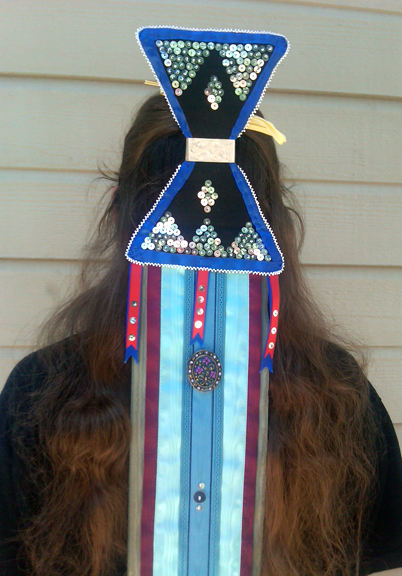Dush-tuh on:
[Wikipedia]
[Google]
[Amazon]
 A dush-toh, also spelled dush-too, dush-tooh, or dush-tuh, is a customary
A dush-toh, also spelled dush-too, dush-tooh, or dush-tuh, is a customary
''Caddo Nation: Heritage and Culture''. (retrieved 3 Feb 2010) Neighboring tribes, such as the Kickapoo and Delaware, have similar women's hair ornaments. A dush-toh consists of an embellished, butterfly- or hourglass-shaped frame that is worn on the back of the head with ribbons that flow down the back, almost to the ground. They were made in the 19th and 20th centuries,Ellison 11 as well as into the present.
 The ribbons, usually of
The ribbons, usually of
Image of Caddo women wearing dush-tohs
Encyclopedia of Arkansas
Dush-toh from 1900Dush-toh from 1880–1900
National Museum of the American Indian {{DEFAULTSORT:Dush-Toh Caddo Fashion accessories Headgear Native American clothing
 A dush-toh, also spelled dush-too, dush-tooh, or dush-tuh, is a customary
A dush-toh, also spelled dush-too, dush-tooh, or dush-tuh, is a customary Caddo
The Caddo people comprise the Caddo Nation of Oklahoma, a federally recognized tribe headquartered in Binger, Oklahoma. They speak the Caddo language.
The Caddo Confederacy was a network of Indigenous peoples of the Southeastern Woodlands, who ...
hair ornament worn by girls and women during dances, particularly the Turkey Dance
The turkey dance (Caddo: Núh Kaʔáwshan) is one of the most important traditional dances among Caddo people.
."Summer Youth Camp."''Caddo Nation: Heritage and Culture''. (retrieved 3 Feb 2010) Neighboring tribes, such as the Kickapoo and Delaware, have similar women's hair ornaments. A dush-toh consists of an embellished, butterfly- or hourglass-shaped frame that is worn on the back of the head with ribbons that flow down the back, almost to the ground. They were made in the 19th and 20th centuries,Ellison 11 as well as into the present.
Frame
The top of the butterfly-shaped frame is typically 4.25 inches wide and the bottom is usually 4-5/8 inches wide. The frame is 7.5 inches tall. The frame can be covered in black felt and edged with colored ribbons on both sides. Further embellishments include whiteseed bead
Seed beads or rocailles are uniformly shaped, spheroidal beads ranging in size from under a millimeter to several millimeters. ''Seed bead'' is also a generic term for any small bead. Usually rounded in shape, seed beads are most commonly used ...
s sewn along the edges and silver studs placed according to the individual's preference. A silver band runs around the narrowest point of the frame, which is tied to the hair.Newkumet and Meredith, 42 A wooden hairpin can also be used to hold the dush-toh in place. German silver
Nickel silver, maillechort, German silver, argentan, new silver, nickel brass, albata, or alpacca is a cupronickel (copper with nickel) alloy with the addition of zinc. The usual formulation is 60% copper, 20% nickel and 20% zinc. Nickel silver ...
spots can be attached to the frame and beaded rosettes may be used to decorate the center of the frame.
Ribbons
 The ribbons, usually of
The ribbons, usually of watered silk
Moire ( or ), less often moiré, is a textile with a wavy (watered) appearance produced mainly from silk, but also wool, cotton, and rayon. The watered appearance is usually created by the finishing (textiles), finishing technique called calender ...
, are attached to the bottom of the headpiece. Four layers of ribbons are typically sewn to one ribbon band, which is sewn to the felt on the frame. Ribbons can be solid colors or plaid. They run down the back to the hemline of the dancer's dress. Bells, or ''cai'-coo-tze'', can be sewn to the bottom for weight and a musical sound. Ribbons can be embellished with shell, mirrors, German silver
Nickel silver, maillechort, German silver, argentan, new silver, nickel brass, albata, or alpacca is a cupronickel (copper with nickel) alloy with the addition of zinc. The usual formulation is 60% copper, 20% nickel and 20% zinc. Nickel silver ...
medallions, or beadwork rosettes.
Classes
The Caddo Nation offers classes in making dush-tohs to Caddo youth during their annual summer camp.Notes
References
* Ellison, Rosemary. ''Contemporary Southern Plains Indian Metalwork.'' Anadarko, OK: Oklahoma Indian Arts and Crafts Cooperative, 1976. Library of Congress Number 75-40659. * Newkumet, Vynola Beaver and Howard L. Meredith. ''Hasinai: A Traditional History of the Caddo People''. College Station: Texas A&M Press, 1988. .External links
Image of Caddo women wearing dush-tohs
Encyclopedia of Arkansas
Dush-toh from 1900
National Museum of the American Indian {{DEFAULTSORT:Dush-Toh Caddo Fashion accessories Headgear Native American clothing